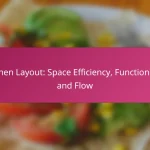Upgrading your kitchen can significantly enhance both its functionality and style without requiring a hefty investment. In Los Angeles, cost-effective improvements such as cabinet refacing, energy-efficient appliances, and stylish backsplashes can transform your space while adding value to your home. By carefully selecting materials and design choices, you can achieve a modern look that appeals to potential buyers and elevates your daily cooking experience.

What are the best cost-effective kitchen upgrades in Los Angeles?
In Los Angeles, the best cost-effective kitchen upgrades focus on enhancing functionality and aesthetics without breaking the bank. Key improvements include cabinet refacing, countertop replacement, energy-efficient appliances, smart lighting solutions, and backsplash installation.
Cabinet refacing
Cabinet refacing involves replacing the doors and drawer fronts of your existing cabinets while keeping the original structure intact. This method can significantly enhance the look of your kitchen at a fraction of the cost of full cabinet replacement, often ranging from $2,500 to $6,000 depending on the size of the kitchen.
When considering cabinet refacing, choose durable materials that match your kitchen’s style. It’s essential to hire a skilled professional to ensure a seamless finish and proper installation.
Countertop replacement
Replacing countertops can dramatically change the kitchen’s appearance and functionality. Popular materials include quartz, granite, and laminate, with costs typically between $1,500 and $4,500 based on the material and kitchen size.
Consider factors such as durability, maintenance, and aesthetics when selecting a countertop. For instance, quartz offers low maintenance, while granite provides a unique, natural look but may require periodic sealing.
Energy-efficient appliances
Upgrading to energy-efficient appliances can lower utility bills and enhance your kitchen’s functionality. Look for appliances with the ENERGY STAR label, which indicates they meet energy efficiency guidelines set by the U.S. Environmental Protection Agency.
While the initial investment may be higher, the long-term savings on energy costs can make these appliances a smart choice. Expect to pay anywhere from $1,000 to $3,000 for a full suite of energy-efficient appliances.
Smart lighting solutions
Implementing smart lighting solutions can improve both ambiance and energy efficiency in your kitchen. Options include LED bulbs, smart switches, and dimmers, with costs typically ranging from $100 to $500 depending on the complexity of the system.
Consider installing under-cabinet lighting or pendant lights to enhance task areas. Smart lighting can also be controlled via smartphone apps, allowing for convenient adjustments based on your needs.
Backsplash installation
Installing a new backsplash can add visual interest and protect walls from splashes and stains. Materials like tile, glass, and metal are popular choices, with costs generally between $800 and $2,500 for materials and installation.
When selecting a backsplash, consider the overall kitchen design and color scheme. A well-chosen backsplash can serve as a focal point and elevate the entire space.

How much do kitchen upgrades cost in Los Angeles?
Kitchen upgrades in Los Angeles typically range from several thousand to tens of thousands of dollars, depending on the scope and materials chosen. Factors such as labor costs, quality of materials, and specific design choices significantly influence the overall price.
Average cost of cabinet refacing
The average cost of cabinet refacing in Los Angeles generally falls between $4,000 and $9,000. This process involves replacing the cabinet doors and drawer fronts while keeping the existing cabinet boxes, making it a cost-effective alternative to full cabinet replacement.
When considering cabinet refacing, choose durable materials that match your kitchen’s style. Be mindful of the contractor’s experience, as skilled professionals can ensure a high-quality finish that enhances your kitchen’s overall appeal.
Countertop installation costs
Countertop installation costs in Los Angeles can range from $2,000 to $5,000, depending on the material selected. Popular options include granite, quartz, and laminate, each varying in price and durability.
When selecting countertops, consider both aesthetics and functionality. For instance, quartz offers a modern look and is low-maintenance, while granite provides a unique, natural appearance but may require more upkeep.
Price range for energy-efficient appliances
The price range for energy-efficient appliances in Los Angeles typically starts around $500 and can exceed $3,000 for high-end models. These appliances are designed to reduce energy consumption, which can lead to savings on utility bills over time.
When shopping for energy-efficient appliances, look for the ENERGY STAR label, which indicates compliance with energy-saving standards. Investing in these appliances can enhance your kitchen’s functionality while contributing to long-term savings and environmental sustainability.

What kitchen upgrades add the most value to a home?
Kitchen upgrades that add significant value to a home include modernizing fixtures, installing open shelving, and upgrading flooring materials. These improvements not only enhance the aesthetic appeal but also increase functionality and marketability.
Modernizing fixtures
Updating kitchen fixtures such as faucets, sinks, and lighting can greatly enhance both style and functionality. Opt for energy-efficient models that reduce water and electricity consumption, which can appeal to eco-conscious buyers. Consider finishes like brushed nickel or matte black, which are currently popular and can complement various design styles.
When selecting fixtures, ensure they are compatible with your existing plumbing and electrical systems to avoid costly modifications. A well-chosen fixture can elevate the overall look of your kitchen without requiring a full renovation.
Open shelving installation
Open shelving is a trendy upgrade that can create a more spacious feel in the kitchen while showcasing decorative items or dishware. This option is often more cost-effective than traditional cabinetry and can be customized to fit your space. Consider using reclaimed wood or metal for a rustic or industrial look.
However, be mindful of maintenance; open shelves require regular cleaning to prevent dust accumulation. When installing, ensure that the shelves are securely mounted and can support the weight of the items you plan to display.
Upgrading flooring materials
Choosing the right flooring can significantly impact the kitchen’s overall aesthetic and durability. Popular options include hardwood, tile, and luxury vinyl, each offering unique benefits. Hardwood provides warmth and timeless appeal, while tile is durable and water-resistant, making it ideal for kitchens.
When upgrading flooring, consider the installation costs and maintenance requirements. For instance, while hardwood may require refinishing over time, tile is generally easier to clean and maintain. Aim for materials that can withstand high traffic and spills to ensure longevity.

What are the key factors to consider before upgrading a kitchen?
Before upgrading a kitchen, it’s essential to evaluate budget constraints, space and layout, and style preferences. These factors will guide your decisions and help ensure that the improvements align with your needs and financial situation.
Budget constraints
Establishing a budget is crucial for any kitchen upgrade. Determine how much you can afford to spend, considering both materials and labor costs. A typical kitchen remodel can range from a few thousand dollars for minor updates to tens of thousands for a complete overhaul.
To manage expenses effectively, prioritize upgrades that offer the best return on investment, such as new countertops or energy-efficient appliances. Avoid overspending by setting aside a contingency fund of around 10-15% of your total budget for unexpected costs.
Space and layout
Assessing your kitchen’s space and layout is vital for maximizing functionality. Consider the work triangle concept, which emphasizes the relationship between the sink, stove, and refrigerator to enhance efficiency. If your kitchen is small, opt for space-saving solutions like open shelving or multi-functional furniture.
When planning the layout, think about traffic flow and accessibility. Ensure that pathways are clear and that there is enough room for multiple people to work comfortably. If structural changes are necessary, consult a professional to understand the implications and costs involved.
Style preferences
Your personal style should significantly influence your kitchen upgrade decisions. Whether you prefer a modern, rustic, or traditional look, choose materials and colors that reflect your taste. For example, sleek stainless steel appliances suit contemporary designs, while wooden cabinets may enhance a farmhouse aesthetic.
To create a cohesive look, consider how your kitchen style will blend with adjacent rooms. Use design elements like backsplashes, lighting fixtures, and cabinet finishes to tie the space together. Research current trends but prioritize timeless features that will remain appealing over the years.

What are the latest trends in kitchen design?
The latest trends in kitchen design focus on functionality, sustainability, and aesthetics. Homeowners are increasingly opting for designs that combine modern technology with timeless style, creating spaces that are both practical and visually appealing.
Minimalist aesthetics
Minimalist aesthetics emphasize simplicity and clean lines, often featuring a limited color palette and uncluttered spaces. This design approach creates a serene environment, making kitchens feel more spacious and organized.
To achieve a minimalist kitchen, consider using flat-panel cabinetry, integrated appliances, and open shelving. These elements help reduce visual clutter while maintaining functionality. A common choice is to use neutral colors, such as whites, grays, and earth tones, which can enhance the feeling of openness.
When implementing minimalist aesthetics, avoid overcrowding countertops with appliances or decorative items. Instead, focus on a few key pieces that add character without overwhelming the space. This approach not only improves the kitchen’s appearance but also enhances its usability.


